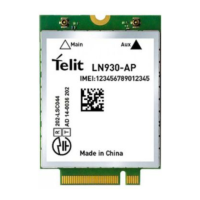
Do you have a question about the Telit Wireless Solutions LN930 and is the answer not in the manual?
| Brand | Telit Wireless Solutions |
|---|---|
| Model | LN930 |
| Category | Storage |
| Language | English |
Document covers M.2 module features, interface, hardware, software, reliability, and specifications.
Provides design guidelines and information for M.2 modules, including signals and requirements.
Intended for editors writing or editing Telit documentation.
Provides contact details for technical support and documentation inquiries.
Describes the manual's structure, listing key chapters for easy navigation.
Explains symbols for Danger, Caution/Warning, and Tip/Information for clarity.
Lists available M.2 modules (2G/3G/LTE) and references feature comparison tables.
Discusses interfaces for interprocessor communication, focusing on USB 2.0 HS.
Details the USB 2.0 HS interface, its compliance, and features like LPM.
Notes that USB SSIC is not supported and signals should be left unconnected.
Describes USIM interface, SIM detection, and design guidelines for SIM socket.
Explains GNSS support for GPS/GLONASS, its features, and power management.
Covers signals for power-up, reset, radio disable, LED status, and SAR input.
Details signals for modem power control and system reset.
Describes the control signal for disabling the module's radio.
Explains the use of LED#1 for status indication.
Describes the output signal to wake the host system.
Explains DPR# signal for SAR compliance and RF power level adjustment.
Discusses GPO signals for external antenna switches and impedance tuning.
Describes how the module manages RF interference from multiple radios.
Details the requirement for a 3.3V power source and ground pins.
Covers USB and JTAG/MIPI PTI ports for system tracing and debugging.
Explains pins used for host identification of the add-in card.
Notes reserved signals for future digital audio interface support.
Lists pins that are not connected on the module.
Describes antenna connector requirements and assignments.
Introduces the carrier board for system test, verification, and debugging.
Describes the utility for downloading binary images to the module's flash memory.
Details the tool for fine-tuning module parameters and accessing interfaces.
Explains the tool for capturing and analyzing trace sub-streams.
Describes the XMMCalTool for RF calibration features.
Explains the tool for measuring and plotting RF noise levels.
Covers the MBIM toolkit including drivers and utilities for Windows.
Details the kernel-level driver for Windows 7/8.
Describes the user-mode driver for GNSS applications on Windows.
Explains the GUI application for updating module firmware.
Details the Windows 8 application for collecting debugging information.
Illustrates the IPC architecture for Linux-based OS.
Explains the multiplexer protocol for logical channels over IPC.
Describes the USB 2.0 HS stack for PC communication.
Covers configuration options for CDC-ACM and CDC-NCM channels.
Details CDC-ACM channels for modem functions and CDC-NCM for network.
Explains default channel config and AT command for customization.
Discusses USB suspend (L1) state for power saving and wake-up.
Explains how PC and modem manage suspend/resume states.
Lists software components for WWAN M.2 on Android.
Provides an overview of software components for Chrome OS.
Covers 3.3V supply requirements and pin connections for power.
Lists typical power consumption targets for LTE and UMTS.
Discusses shielding, noise filtering, and platform noise tolerance.
Explains adaptive clocking for reducing RF interference from display pixels.
Provides transmit power specifications for 2G, 3G, and LTE.
Defines receiver sensitivity and provides GSM sensitivity limits.
Offers guidance on impedance, shape, polarization, and input power for antennas.
Details the physical dimensions and pin configuration of the WWAN card.
Illustrates typical land patterns for connector mounting.
Shows connector positions and assignments for antennas.
Declares compliance with the 1999/5/EC Directive in multiple languages.
Addresses EU RF exposure requirements and installation distance.
Outlines requirements for R&TTE Directive Articles 3.1(a) and (b).
States that unauthorized modifications void user authority.
Instructs OEM integrators on information for end-user manuals.
Covers FCC and IC compliance regarding interference.
Details FCC Class B limits and installation requirements.
Specifies FCC/IC radiation exposure limits and separation distance.
Describes labeling requirements for the final device.